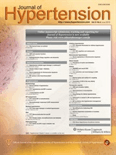
JOURNAL OF HYPERTENSION
Scope & Guideline
Driving innovation in hypertension management and treatment.
Introduction
Aims and Scopes
- Clinical Implications of Hypertension:
Research is aimed at understanding the clinical implications of hypertension, including its impact on patient outcomes, adherence to medication, and quality of life. - Pathophysiology and Mechanisms:
A core focus is on the underlying mechanisms of hypertension, including genetic, molecular, and environmental factors contributing to its development. - Innovative Therapeutics and Management Strategies:
The journal publishes studies on novel therapeutic approaches, including pharmacologic and non-pharmacologic interventions, and their effectiveness in managing hypertension. - Population Health and Epidemiology:
Research on the epidemiology of hypertension, including prevalence, risk factors, and health disparities is prominently featured to inform public health strategies. - Technological Advances in Hypertension Monitoring:
The journal emphasizes the role of technology in hypertension management, including home blood pressure monitoring and telehealth solutions. - Patient-Centered Care and Patient Experiences:
The importance of patient perspectives, experiences, and engagement in hypertension management is explored, aiming to enhance care delivery.
Trending and Emerging
- Hypertension and Comorbidities:
Recent publications increasingly examine the relationship between hypertension and comorbid conditions such as diabetes, chronic kidney disease, and cardiovascular diseases, emphasizing integrated care. - Impact of Social Determinants on Hypertension:
Research focusing on the influence of social determinants of health on hypertension prevalence and management is gaining traction, highlighting health disparities and access to care. - Telehealth and Remote Monitoring:
There is a significant rise in studies exploring the effectiveness and implementation of telehealth and remote blood pressure monitoring, particularly in the context of the COVID-19 pandemic. - Focus on Patient-Centered Outcomes:
Emerging themes include the exploration of patient-reported outcomes and experiences, aiming to personalize hypertension care and improve adherence to treatment. - Intervention Studies in Diverse Populations:
There is an increasing emphasis on intervention studies targeting diverse populations, addressing cultural and socioeconomic factors in hypertension management.
Declining or Waning
- Traditional Pharmacological Approaches:
There is a noticeable reduction in research centered on traditional antihypertensive medications, as newer therapies and combination strategies gain more interest. - Single-Disease Focus Studies:
The trend is shifting away from studies that examine hypertension in isolation, as there is a growing recognition of its interplay with other chronic conditions. - Basic Science Studies:
Research focusing solely on basic science aspects of hypertension without clinical implications or applications has seen a decrease in publication frequency, reflecting a preference for translational research.
Similar Journals

JOURNAL OF HUMAN HYPERTENSION
Advancing knowledge on hypertension for a healthier tomorrow.JOURNAL OF HUMAN HYPERTENSION, a prominent publication in the field of internal medicine, is dedicated to advancing the understanding of hypertension and its implications for human health. Published by SPRINGERNATURE in the United Kingdom, this esteemed journal has been a vital resource for researchers and clinicians since its inception in 1987, with a continuous commitment to disseminating high-quality, peer-reviewed research. With an impressive Q2 category rank in Internal Medicine and a Scopus rank of 53 out of 167, it occupies a crucial position within the academic community, reaching a 68th percentile ranking that underscores its significance. The journal aims to provide a platform for innovative studies and reviews, fostering knowledge that bridges basic science, clinical practice, and public health. Although it does not currently offer open access, it remains accessible through institutional subscriptions, ensuring that vital information about hypertension is available to a broad spectrum of healthcare professionals and researchers. Explore the critical findings and groundbreaking research published in the JOURNAL OF HUMAN HYPERTENSION to stay at the forefront of hypertension studies.
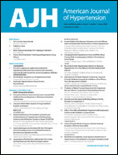
AMERICAN JOURNAL OF HYPERTENSION
Elevating standards in hypertension care and research.American Journal of Hypertension, published by Oxford University Press, is a leading peer-reviewed journal dedicated to the field of hypertension and cardiovascular health. With an ISSN of 0895-7061 and an E-ISSN of 1941-7225, this prestigious journal has been providing researchers and clinicians with significant advancements in hypertension research since its inception in 1954, with a continued focus on innovative studies through 2024. Ranked Q2 in Internal Medicine and positioned within the top 22% of its category according to Scopus, it is a vital resource for those involved in clinical practice and research aimed at understanding and managing hypertension. The journal disseminates pivotal findings, treatment updates, and guideline recommendations that contribute to improved patient care globally. Accessible solely through subscription, the American Journal of Hypertension is essential reading for professionals committed to enhancing cardiovascular health outcomes.

JOURNAL OF NEPHROLOGY
Championing advancements in nephrology since 1989.JOURNAL OF NEPHROLOGY is a premier academic journal dedicated to the field of nephrology, published by Springer Heidelberg. With its ISSN 1121-8428 and E-ISSN 1724-6059, this journal serves as a dynamic platform for disseminating high-quality research and groundbreaking findings in kidney health and disease. Since its inception in 1989, it has established itself as a vital resource for professionals, researchers, and students, consistently ranking in the top quartile (Q1) of nephrology journals and securing an impressive Scopus rank of #19 out of 81, placing it in the 77th percentile. Although it operates under a subscription model, the journal fosters an inclusive academic environment where critical discussions and innovative approaches to nephrological challenges are encouraged. With a commitment to advancing knowledge and practice in nephrology, JOURNAL OF NEPHROLOGY remains an essential resource for anyone who seeks to stay at the forefront of kidney research and clinical care.
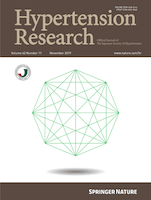
HYPERTENSION RESEARCH
Connecting researchers and practitioners in hypertension studies.HYPERTENSION RESEARCH, published by SpringerNature, serves as a premier platform in the field of Cardiology and Cardiovascular Medicine, Internal Medicine, and Physiology. Since its inception in 1992, the journal has built a substantial reputation, currently ranked in the second quartile (Q2) across several categories in 2023, reflecting its influence and high-quality contributions to medical research. With a focus on hypertension, the journal aims to disseminate vital research findings, clinical studies, and innovative treatment strategies to a diverse audience of researchers, healthcare professionals, and students, fostering knowledge exchange in the management of hypertensive conditions. Although it is not an Open Access journal, it offers comprehensive access to its extensive archive of valuable resources, ensuring that critical advancements in the understanding of hypertension are both accessible and impactful. HYPERTENSION RESEARCH is not only essential for those directly involved in cardiovascular and internal medicine practices but also for interdisciplinary scholars who are looking to explore the intersections of physiology and other biomedical fields in their work.

HEART AND VESSELS
Transforming Heart Health Through Scholarly ExcellenceHEART AND VESSELS is a prominent peer-reviewed journal published by SPRINGER, dedicated to advancing the fields of cardiology and cardiovascular medicine. With its ISSN 0910-8327 and E-ISSN 1615-2573, this esteemed journal encompasses a broad range of topics pertinent to heart health, vascular function, and associated therapies, making it an essential resource for researchers, clinicians, and healthcare professionals alike. Based in Japan and operating since 1985, HEART AND VESSELS has consistently maintained a Q2 ranking in the 2023 category quartiles, highlighting its relevance and impact in the cardio domain. Although it does not offer open access, the journal ensures high-quality publications that contribute significantly to the academic and clinical understanding of cardiovascular health. With over three decades of continuous scholarly contribution, HEART AND VESSELS serves as a vital platform for disseminating cutting-edge research and fostering innovative practices in the management of cardiovascular diseases.
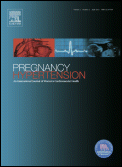
Pregnancy Hypertension-An International Journal of Womens Cardiovascular Health
Innovating Women's Health: Cardiovascular Insights for Expecting MothersPregnancy Hypertension – An International Journal of Women's Cardiovascular Health, published by Elsevier Science Ltd, is a leading platform dedicated to advancing the understanding of cardiovascular health in women during pregnancy and postpartum periods. With an ISSN of 2210-7789, this esteemed journal has distinguished itself in the fields of Internal Medicine and Obstetrics and Gynecology, maintaining a remarkable Q2 ranking in Internal Medicine and a prestigious Q1 ranking in Obstetrics and Gynecology as of 2023. It is recognized for its high-quality research, which fits within the top quartile of its categories, and spans from 2010 to 2024, reflecting its ongoing contribution to critical advancements in women's cardiovascular health. The journal is accessible to a global audience of researchers, practitioners, and students, emphasizing its commitment to promoting open scholarly communication, although it currently operates under traditional access. The publication serves as a crucial resource for those seeking to enhance their knowledge and practices related to the unique cardiovascular challenges faced by women during pregnancy, thereby fostering informed clinical approaches and improved health outcomes.
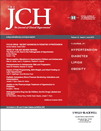
Journal of Clinical Hypertension
Empowering Insights for a Healthier HeartJournal of Clinical Hypertension, published by WILEY, is a leading open-access journal focused on advancing the understanding and treatment of hypertension and related cardiovascular conditions. With an ISSN of 1524-6175 and an E-ISSN of 1751-7176, the journal provides a vital platform for researchers, healthcare professionals, and students alike to disseminate high-quality, peer-reviewed research. Since transitioning to open access in 2021, it has increased its reach and accessibility, ensuring critical information is available to a broader audience. The journal holds an impressive position in the Scopus ranks, nestled within the Q2 quartile across key disciplines including Cardiology and Cardiovascular Medicine, Endocrinology, Diabetes and Metabolism, and Internal Medicine, indicating a strong impact on the scientific community. With articles converging from 2001 to 2024, it not only highlights contemporary developments but also contributes to the ongoing dialogue in the field. Researchers are encouraged to submit their findings on hypertension, treatment methodologies, and epidemiology to further enhance the collective knowledge in this crucial area of health.

AKTUELLE RHEUMATOLOGIE
Transforming rheumatology through shared knowledge and research.AKTUELLE RHEUMATOLOGIE is a prominent German journal published by GEORG THIEME VERLAG KG, dedicated to advancing the field of rheumatology. Since its inception in 1978, this peer-reviewed journal has been a vital resource for professionals, researchers, and students engaged in the study and treatment of rheumatic diseases. With an ISSN of 0341-051X and an E-ISSN of 1438-9940, the journal provides a platform for sharing groundbreaking research, clinical studies, and reviews. Although classified in the fourth quartile (Q4) of rheumatology journals and ranked 67 out of 73 in its category according to Scopus, AKTUELLE RHEUMATOLOGIE continues to contribute to the discourse in rheumatology. Its comprehensive coverage of recent advancements and innovative approaches makes it an essential publication for anyone interested in the latest developments in the field.

HYPERTENSION
Innovating treatment strategies for better outcomes.HYPERTENSION, published by Lippincott Williams & Wilkins, is a preeminent journal in the field of cardiovascular medicine, focusing on the latest research, therapies, and clinical practices related to hypertension and its associated disorders. With a distinguished Q1 ranking in Internal Medicine and a commendable Scopus rank of #12 out of 167 in its category, it occupies a vital position within the academic community, appealing to researchers, clinicians, and educators alike. The journal has been disseminating impactful findings since 1979 and continues to influence the discourse on hypertension through rigorous peer-reviewed articles, reviews, and studies designed to elevate understanding and treatment of this prevalent condition. HYPERTENSION remains an essential resource for professionals keen on advancing their knowledge in this critical area of medicine, fostering innovations that ultimately improve patient care.

Clinical Hypertension
Fostering innovation in cardiovascular health.Clinical Hypertension is a premier journal dedicated to advancing the field of hypertension and cardiovascular health, published by SpringerNature. Since its transition to an Open Access model in 2014, the journal has opened doors for researchers globally to share their findings without barriers, aiming to foster collaboration and innovation in this vital area of medicine. With a current impact factor that positions it in the Q2 quartile for both Cardiology and Cardiovascular Medicine and Internal Medicine, Clinical Hypertension is recognized for its scholarly contributions, reflected in its Scopus rankings (Rank #100/387 in Cardiology and Rank #52/167 in Internal Medicine), which place it in the top percentiles of these competitive fields. Covering a diverse range of topics within hypertension research, it serves as an essential resource for clinicians, researchers, and students alike, promising to keep its audience informed of the latest developments and breakthroughs from its inception in 2017 through to 2024.